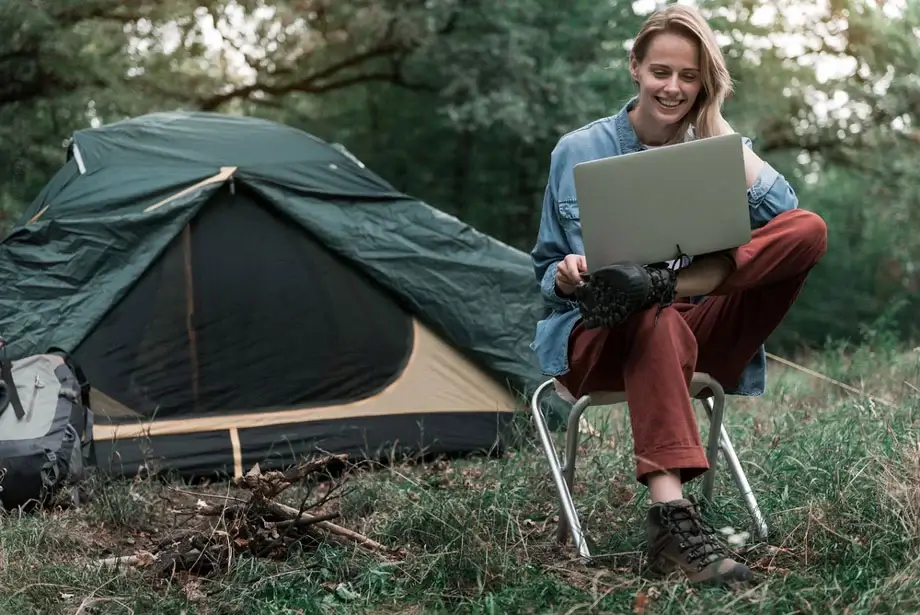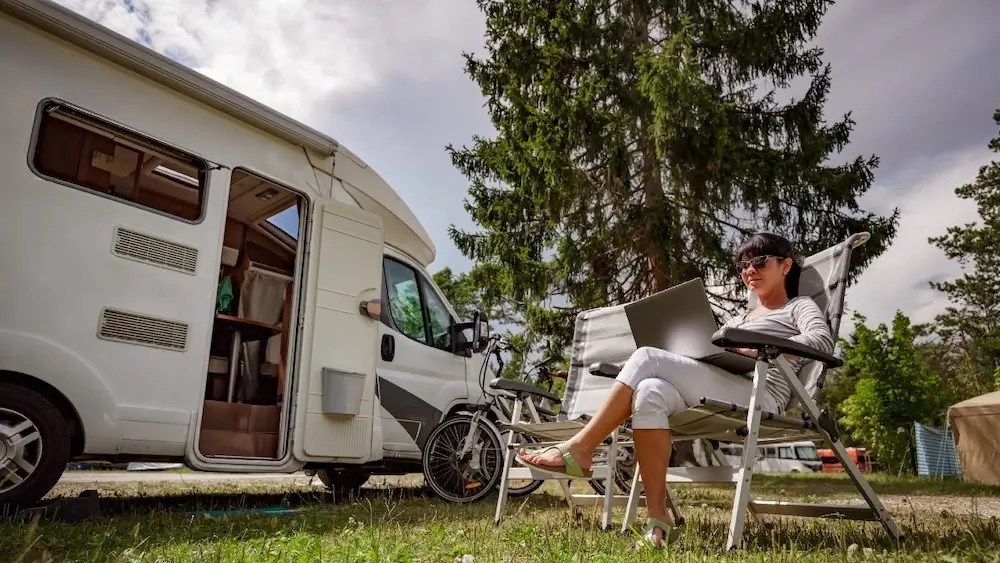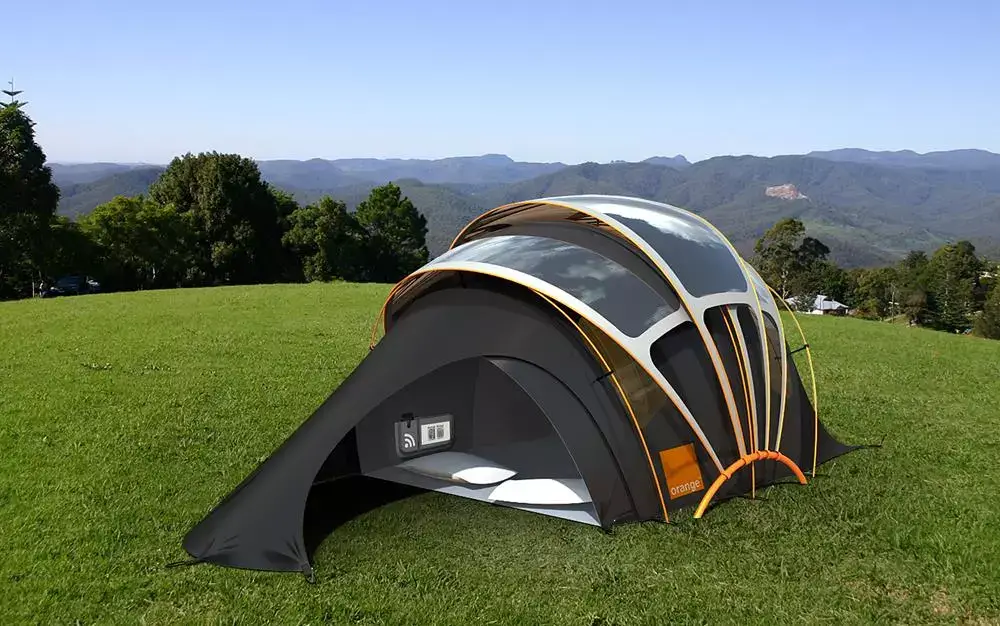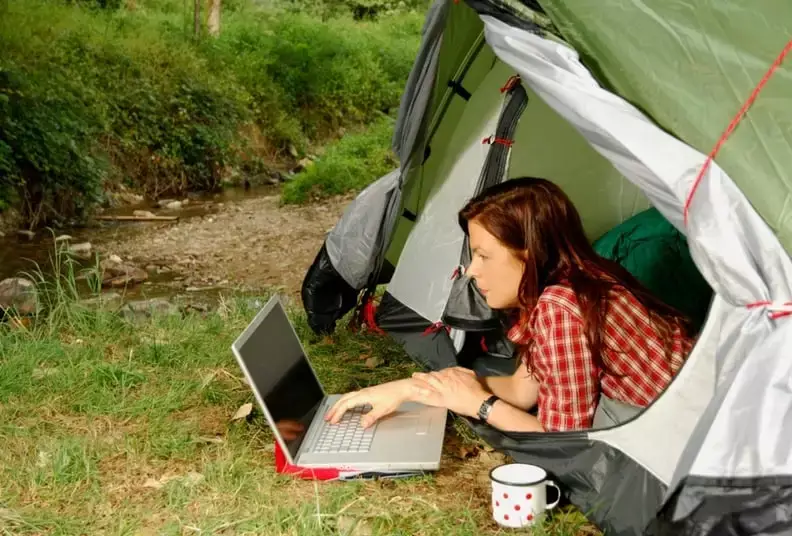If you are the type of person who loves to get back to nature, then camping is for you. Camping gives you a chance to escape from all of the distractions that we face on an everyday basis and just enjoy the outdoors with your friends or family.
If there’s one thing that can ruin it though, it’s not being able to stay connected with everything going on in our digital world. We’ve put together 9 tips for how to get internet while camping so you can still keep up with what’s happening.
If you’re looking for a more permanent solution, or if you’re going to be camping in an area without cell service, then investing in a portable Wi-Fi hotspot is a great option.
These devices allow you to create your own personal Wi-Fi network anywhere there is cellular coverage, so you can stay connected with no problem.
Finally, if you’re just looking to check your email or post a quick update to social media, there are a few things you can do to stay connected without using up all of your data.
Connecting to public Wi-Fi is always an option, and most browsers have a built-in feature that will allow you to use less data while browsing the internet.
Nine Different Methods to Get Internet While Camping

1. Use Your Smartphone as a Hotspot
The first step in your journey to Wi-Fi nirvana is to activate your smartphone’s hotspot capabilities. This should be a quick and easy process:
* Turn on the phone; * Go into settings, select “Wireless & networks” or something similar (this might depend on what phone you use); * Select “Tethering & mobile hotspot” or something similar; * Toggle the switch to “on.”
With that done, you can plug your other devices into your phone via USB cables and enjoy a Wi-Fi signal without worrying about dead batteries.
The same process applies to tablets, but because they have larger batteries, you can also use them to charge your devices.
2. Bring a Wireless Router
If you’re traveling with a group of people, it’s likely that not everyone will have a smartphone with hotspot capabilities.
In this case, you can bring your own wireless router. This is a small device that creates its own Wi-Fi network, allowing multiple devices to connect at the same time.
Just be sure to pack it in your checked baggage; these devices are considered the same as any other electronics, and they’re likely to get lost or stolen if you bring them into the cabin.
The best part: You can usually pick one up at a thrift shop for less than $20, meaning it’s not too much of an investment even if something does happen to it on the road.
3. Rent a Portable Wifi Unit
If you do not own a portable wifi unit, some locations sell them to people who are camping. These units typically have service packages that range from 100 MB-500MB of transfer bandwidth per day.
This is usually sufficient for standard tasks such as checking email, social media networks, and browsing the internet with little difficulty.
4. Buy a Prepaid Data Plan from a Cellular Provider
Connecting to a cellular network is often the best way to get online if you’re far from any public WiFi hotspots.
Most carriers have data plans available for purchase that cover several days or weeks of access, so it can be a relatively inexpensive option as well.
If you don’t want to purchase a data plan, some cellular providers also offer pay-as-you-go rates for access. Just be sure to research the coverage in the area where you will be camping, as not all networks have equal reach.
5. Connect to the Internet Using Your Vehicle’s Built-In Modem
If you have a newer vehicle, it’s likely that it has a built-in modem that can be used to connect to the internet. This is a great option if you’re camping in an area with good cellphone coverage.
All you need is an adapter to plug into your car’s cigarette lighter and a data plan from your cell carrier.
Plugin the adapter and turn on your cellular data. If you don’t have a built-in modem, all major cell carriers now offer some kind of mobile hotspot or wireless internet device that can be used as an alternative to a traditional computer connection.
No matter what option you go with, it’s important to remember that these devices use data fast. Therefore, it’s important to keep track of how much you’re spending and use only what you need while on the road.
Use a mobile hotspot or wireless internet device if your vehicle doesn’t have a built-in modem.
6. Ask to Use the Campground’s Wifi Network
If you’re staying at a campground with wifi, simply ask the staff if you can use the network. If there’s no campground wifi, see if there are any open networks in the area that you can connect to. Sometimes it costs money to access the network though, so be sure to check before trying to connect.
7. Find an Open Wifi Connection to Join
One of the best ways to stay connected while camping is by finding an open wifi connection to join.
This can be done by using a site like OpenWifiSpots or WiFi Finder. These sites will show you all of the nearby open wifi connections and allow you to connect easily.
8. Use a Satellite Internet Service Provider
Use a satellite internet service provider to stay connected while camping in the wild. This is an effective and affordable method for boosting your signal when you can’t get any bars on your phone or laptop.
These services also tend to be reliable, since they’re not communicating with cell towers that might fail during bad weather conditions.
Satellite internet is best for streaming media like Netflix since the download speeds are fast. You can also use this option to share files with friends or access your email quickly while off the grid.
The only downside to satellite internet is that it can be slow for browsing the web and downloading large files.
If you’re looking to do a lot of online work while camping, this might not be the best option for you. But for basic needs like checking email and watching movies, it’s perfect.
9. Get a Wifi Connection from an RV Owner or Campervan Renter

Many RV owners and campervan renters are more than happy to share their wifi connection with passers-by. If you can find someone traveling in the same direction as you, ask if you can connect to their network. Most people will be happy to help out a fellow traveler.
If there’s no one around who is willing to share their wifi, you can purchase a portable hotspot. These devices allow you to create your own wireless network wherever you are.
Install WiFi in Your RV
If you don’t want to bother with connecting your phone or computer to another network, there are many companies that offer wifi for RVs. You can find both large and small systems depending on the size of your RV or campervan.
Also read: How Much Wind Can a Tent Withstand (Conditions and Factors)
How to Set Up Your Internet During Camping Using a USB Modem
First, make sure that your device has a USB port. Most laptops and phones do, but if you’re not sure, check the specifications. Next, gather the following items: an internet USB stick, a laptop or phone charger, an extension cord (optional), and a tent or tree branch (optional).
Once you have all of your supplies together, follow these steps to set up your internet connection:
Plug the USB stick into your device. Plug the charger into the USB stick. Connect the extension cord to the charger, if necessary. Find a spot at your campsite where you can get good reception.
If you’re using a tent, find an open spot with no trees or obstructions overhead. If you’re using a tree branch, find a sturdy branch that’s high enough off the ground. Connect your device to the internet USB stick.
How to Connect Your Cell Phone to the Internet While Camping
If you’re looking for a way to stay connected while camping, your cell phone can be a great resource. By following these simple tips, you can set up your internet through your cell phone and stay connected to the outside world.
First, you want to make sure that your cell phone is capable of connecting with the internet. Some smartphones are able to connect through wifi while others can only use cellular data.
If this is the case for your phone, you’ll have to find a way around it by using an old smartphone or tablet so that you can tether your device and get online.
If your cell phone is capable of using wifi, you’ll want to make sure that it can be used as a hotspot. You can do this by opening up the settings on your smartphone and clicking “Cellular” or heading into Settings > Personal Hotspot.
This should vary depending on which iPhone you have. Enter in an easy-to-remember name for your hotspot and make sure that the password is something you’ll remember.
Now, turn on your hotspot by toggling the switch next to it. You should see a small yellow icon in the top-left corner of your screen with the word “Hotspot” next to it. This means that your hotspot is active and ready to go.
If you’re trying to connect to the internet through your cell phone, you’ll need to have the password for the hotspot that you created. If someone else is trying to use your hotspot, they’ll need your password in order to get online.
Recommended: 3 Season vs 4 Season Tent: Which One Should You Choose?
How to Connect Your Wi-Fi Extender for Camping
When you’re camping, there’s a good chance that you’ll be in an area with spotty or no Wi-Fi reception.
If this is the case, don’t worry – there are ways to get around it. By using a Wi-Fi extender, you can amplify the signal from your router and increase your range.
A Wi-Fi extender, also known as a range extender or wireless repeater, is a device that connects to your home network and extends the reach of your Wi-Fi signal.
This means that you can get online in areas of your house where you normally wouldn’t be able to.
There are a few different ways to set up a Wi-Fi extender. The first is to purchase a wireless range extender, which plugs into your router and has an antenna that broadcasts the internet signal in another area of your house or campsite.
The second way to set up a Wi-Fi extender is by setting it up through your computer or phone. By going onto a browser, you can connect to the extender and set it up through your home network. This is great if you want to use multiple extenders throughout your campsite or house.
The third way to set up a Wi-Fi range extender is by doing it manually without any help from technology, which might be necessary when camping in an area with no Wi-Fi.
To do this, you’ll need to connect your device directly to the extender’s network and input a few lines of code as directed by its manual.
If you’re looking for a way to get online when camping or in an area with spotty reception, using a Wi-Fi range extender is one of the easiest and most cost-effective ways to amplify your internet.
How to Find Wi-Fi Nearby When Camping
– Make sure you’re armed with your smartphone’s Wi-Fi finder. Some smartphones have this built-in, while others need an app like the free Wireless Finder which uses GPS to tell you where local networks are located around you – including their signal strength and what kind of encryption they use. This is especially useful if there isn’t a network nearby that you can see.
– If there’s a McDonalds, Starbucks, or some other business with free Wi-Fi near your campsite, take advantage. Most of these places offer Wi-Fi passwords on their receipts so you can stay connected even while on the go. Just be careful about how much data you use – streaming videos or music can eat up your monthly allotment quickly.
– If you have a cable modem or other type of internet connection box with an Ethernet port, bring it camping with you. This will allow you to connect directly to the internet without having to go through a wireless network. Just make sure you have an Ethernet cable long enough to reach from your campsite to the box.
– If you’re really stuck, there are a few satellite internet providers that offer service in remote areas where traditional broadband or cellular data service is unavailable. Prices for these services can be expensive, but they may be your only option if you’re looking to stay connected while camping in a rural area.
How to Connect Your Satellite Internet When Camping
– If you want to stay connected while camping and don’t mind paying a bit extra, satellite internet is the way to go. With some providers, you can get speeds that will rival those of standard broadband service.
There are two main types of satellite Internet services: direct broadcast and VSAT (very small aperture terminal). Direct broadcast uses an antenna to send and receive signals directly from a satellite, while VSAT uses a smaller, more portable antenna that connects to a satellite dish at your campsite.
– Setting up a satellite Internet connection is usually pretty easy – most providers have customer service representatives who can help walk you through the process.
All you need is an unobstructed view of the southern sky, a clear view of the satellite’s orbit path from your location (ask your provider where you should place the antenna), and an Internet connection box to connect it all together.
– You can set up a direct broadcast or VSAT service using either corded devices that are permanently mounted at your campsite or mobile equipment that you carry with you. The latter is a great option if you’re camping in different locations and want to be able to get online quickly and easily.
– Prices for satellite Internet service vary depending on the provider, your location, and the amount of data you plan to use each month. Make sure you do your research before signing up so you know what to expect.
Stay connected while camping with these 11 essential tips to save data:
–Use your smartphone as a hotspot: If you have an unlimited data plan, using your phone as a hotspot is a great way to stay connected. This option only works if you are in an area with cell service, and it can quickly use up your data.
–Use public Wi-Fi: Connecting to a public Wi-Fi network is a great way to access the internet without using all of your data. Most browsers have a setting that will allow you to limit how much data you use while browsing the web, so take advantage of this option if you are short on gigs.
–Skip social media: Social media can be a great way to stay connected with friends and family, but it also uses up a lot of data. If you’re not planning on checking your email or chatting frequently, then this is an easy way to save some megabytes.
–Turn off auto-updates: We all love our apps updating automatically, but if you’re not around a reliable Wi-Fi network then this can be bad news for your data.
–Know the weather forecast: The weather is something that we have no control over while camping, so it makes sense to plan ahead and know what to expect before leaving home. Checking the forecast beforehand will ensure that you are prepared for any changes in the weather.
–Keep track of your data usage: One great way to make sure you don’t go over your monthly plan is by keeping a close eye on how much data you are using. Most devices will automatically let you know when you’re getting low, but it’s always smart to check beforehand.
–Download offline maps: If you’ll be out of range from a reliable Wi-Fi network, it’s always smart to have an offline map. This will give you the option to get directions and look up information without eating into your data plan.
–Limit calls & texts: One easy way to stay connected is by limiting how much time that people spend on their phones. If you have friends or family members who tend to overuse your data, then limit the amount of time that they can chat for.
–Download updates before leaving: Updating your software while connected to Wi-Fi is a great way to save some extra money on mobile data. Make sure all apps are up to date and ready to go before leaving home, so you don’t have to worry about it while out in the wild.
–Invest in a portable Wi-Fi hotspot: If you’re going to be camping in an area without cell service, or if you just want a more permanent solution, investing in a portable Wi-Fi hotspot is a great option. These devices allow you to create your own personal Wi-Fi network anywhere there is cellular coverage, so you can stay connected with no problem.
–Browsing the internet: Browsing the internet on a smartphone or tablet uses less data than streaming music or video content. If you’re not planning on watching any Netflix while camping, then limit your streaming to music and turn off the video option.
-Don’t stream any content: If you plan on watching Netflix, YouTube, or doing some other kind of online video viewing while camping this is a great way to go over your data. This isn’t always possible for most people, but if it’s an option then try turning Wi-Fi off if you can.
-Limit your use of apps: If there are certain games or other apps that you don’t need to have on while camping, then try leaving them at home. This is a great way to save some data without compromising the experience in any way.
Conclusion
How to get internet while camping? We hope that you found these tips helpful and will be able to stay connected while camping. Remember, practice makes perfect so don’t be afraid to try out a few different methods until you find the one that works best for you. And most importantly, have fun. Happy camping!


